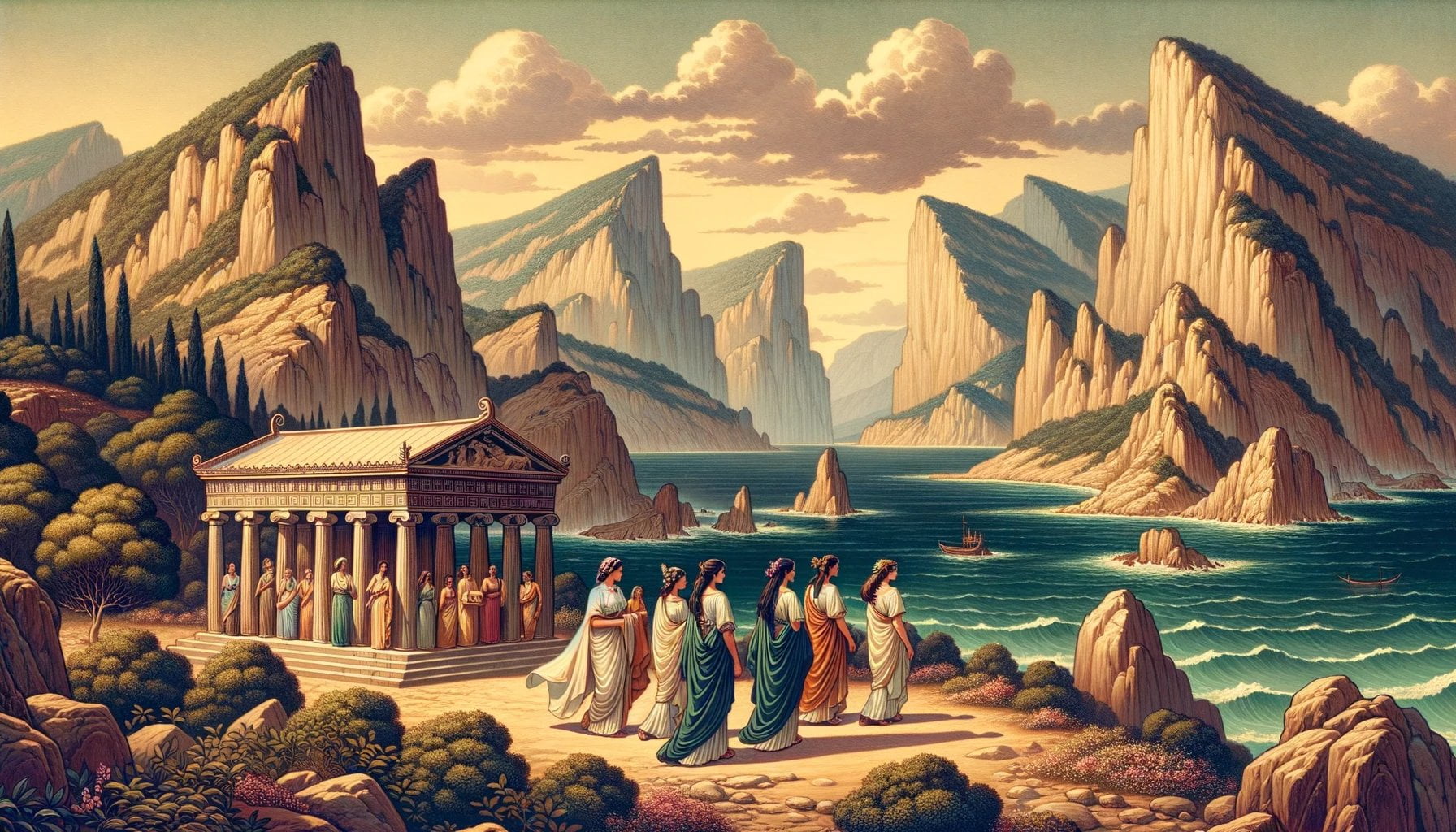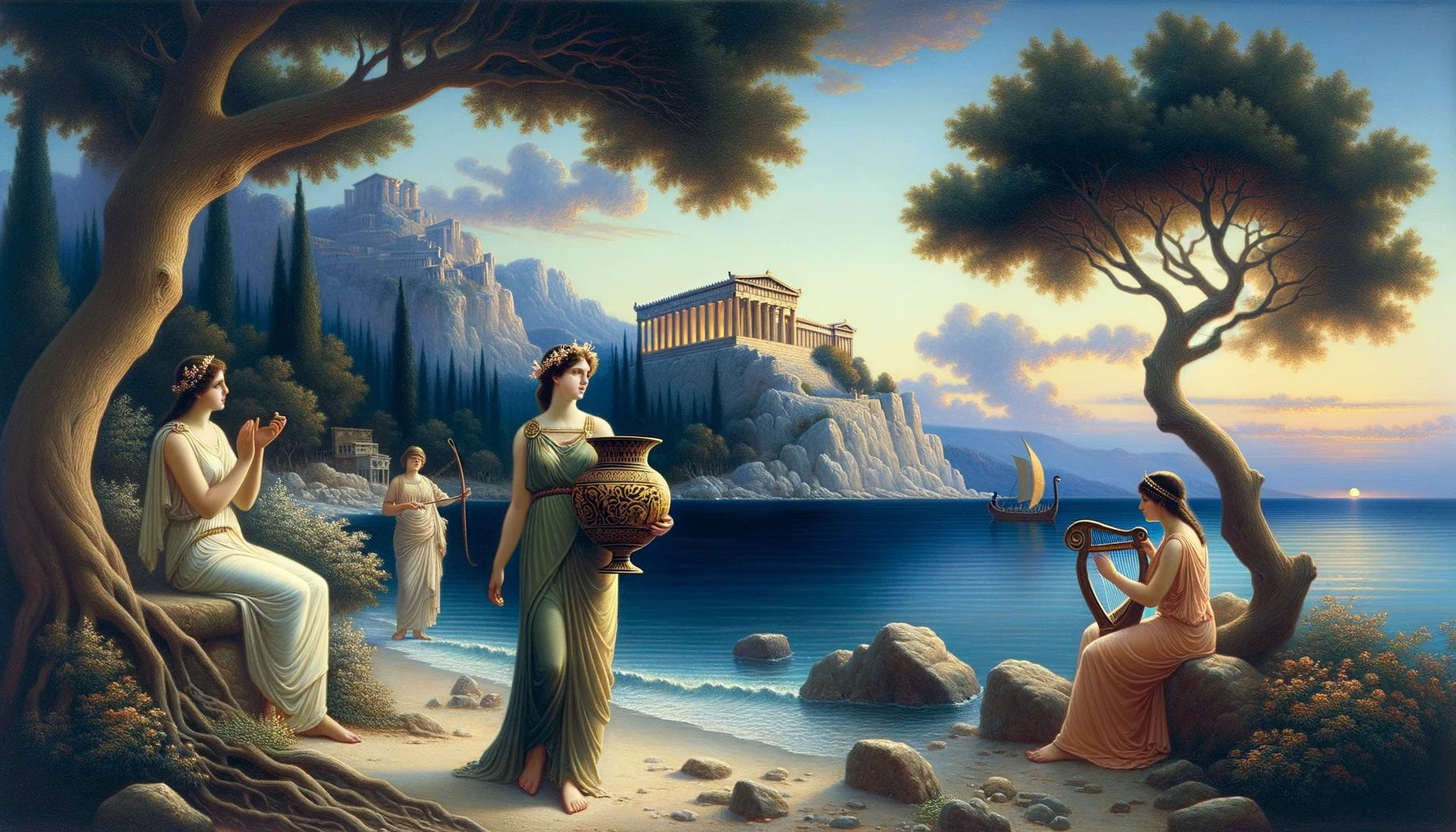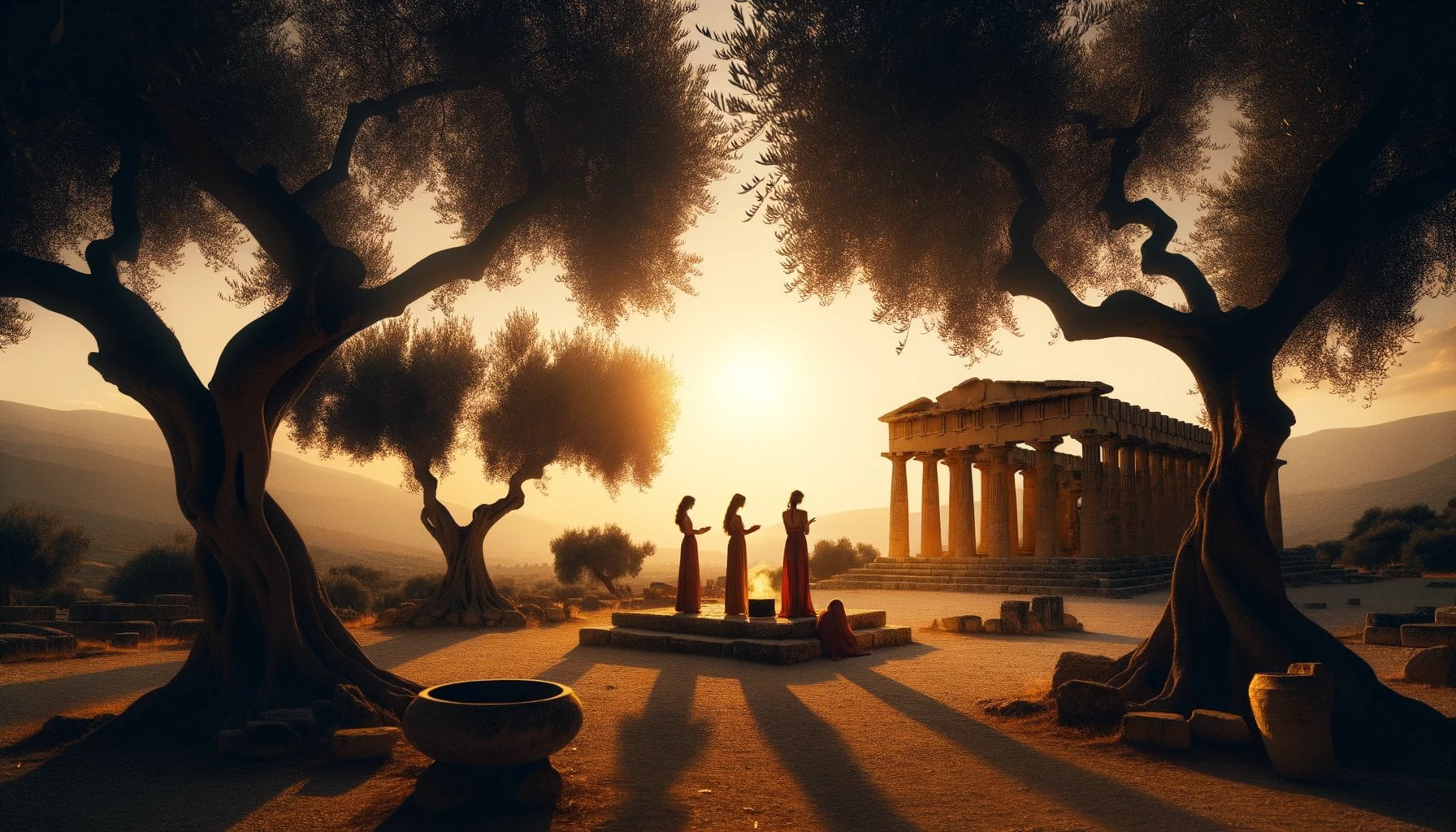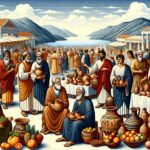Step into the captivating world of ancient Greece, where powerful women held a sacred position unlike any other. In this article, we delve into the realm of priestesses, the enigmatic figures who occupied a unique space in Greek society. Exploring their spiritual duties, influence, and the profound impact they had on the cultural and religious fabric of the time, we unveil the power and significance of these sacred women. Join us on a journey through the depths of ancient Greek history as we uncover the hidden stories of the priestesses, illuminating their remarkable roles in shaping a civilization steeped in myth and mystique. Welcome to “Sacred Women: Unveiling the Power of Priestesses in Ancient Greece.”

Key Takeaways:
- Priestesses in ancient Greece, known as Hiereiai, served crucial roles in the rituals and ceremonies dedicated to the Greek goddesses.
- Priestesses held a unique position in Greek society, as they were among the few women with status and power.
- State funerals and political power were perks for ancient Greek priestesses.
- The Oracle of Delphi, Pythia, was considered the most important and influential priestess in ancient Greece.
- Different types of priestesses existed, each with specific responsibilities and duties.
- The annual festival of Thesmophoria was an exclusive celebration for women and showcased the significant role of priestesses in Greek religious practices.
Priestesses in Ancient Greece
Imagine being one of the few women in ancient Greece who held status and power. The priestesses, known as Hiereiai, had a unique position in Greek society. They served the Greek goddesses through rituals and ceremonies, playing crucial roles in religious practices. Today, we will delve into the intriguing and sacred world of priestesses in ancient Greece.
The Power of the Priestesses
Priestesses were instrumental in serving the Greek goddesses in various rituals. They were the conduits between the mortal and divine realms, bridging the gap between humans and gods. Their duties included performing sacred ceremonies, interpreting omens and prophecies, and conducting sacrifices.
Among the priestesses, the Oracle of Delphi, also known as Pythia, held the most significant and influential position. She was the high priestess at the Temple of Apollo in Delphi and served as the mouthpiece of the god. People from all over Greece would seek her guidance and advice, believing her words to be divinely inspired.
The Role of Priestesses in Society
While men also served as priests in ancient Greece, the female priestesses held a special place in society. They were respected and revered for their spiritual duties and connections to the divine. In addition to their religious roles, priestesses enjoyed certain perks and privileges.
State funerals were often presided over by priestesses, highlighting their involvement in important political events. They also had opportunities for participation in public life and held positions of influence. The annual festival of Thesmophoria was a celebration exclusively for women, showcasing the pivotal role of priestesses in Greek religious practices.
Various Types of Priestesses
There were different types of priestesses in ancient Greece, each with specific responsibilities and duties. Some priestesses were devoted to a particular goddess, such as Athena or Demeter, while others had a broader role in worshiping multiple goddesses.
The Hiereiai, the female priesthood, covered a wide range of priestesses. They could be found in various temples and sacred sites throughout Greece. These priestesses were responsible for performing rituals, maintaining sacred spaces, and ensuring the smooth running of religious ceremonies.
Unveiling the Hidden World
The world of ancient Greek priestesses is a fascinating and often mysterious realm. Through their rituals and ceremonies, they not only served the goddesses but also shaped the religious and cultural landscape of the time. Their influence extended beyond the temples and reached into political and public spheres.
The power of the priestesses in ancient Greece cannot be underestimated. Their unique position, deep spirituality, and connections to the divine elevated them to respected and influential figures in society. As we explore the rich tapestry of ancient Greek history and mythology, the role of priestesses stands as a testament to the significance of women in shaping societies throughout the ages.
To learn more about the captivating world of priestesses in ancient Greece, you can visit the following sources:
- Wikipedia – Hiereiai
- GreekReporter.com – Priestesses Among Few Women Who Had Status, Power in Ancient Greece
In these sources, you can find additional in-depth information on the intriguing topic of priestesses in ancient Greece.
This summary was generated using AI based on multiple online sources. To view the original source information, use the “Learn more” links.
In ancient Greece, there were many influential and powerful women who made their mark in history. From leaders and rulers to scholars and warriors, these famous females played a significant role in shaping Greek society. If you want to learn more about these remarkable women, click here to discover their stories.
The queens of ancient Greece held great power and influence. They were not just figureheads, but active rulers who made important decisions for their kingdoms. If you are curious about the lives of these formidable women, click here to delve into their fascinating world.
The kings of ancient Greece were revered as gods and played a pivotal role in shaping the ancient Greek civilization. If you want to explore the lives and legacies of these legendary rulers, click here and step into the realm of the mighty kings of ancient Greece.
Transportation was a crucial aspect of life in ancient Greece. From chariots and horseback riding to boats and ships, the Greeks had various means of getting from one place to another. Curious to know more about the methods of transportation in ancient Greece? Click here to embark on a journey through time.
Ancient Greece was no stranger to conflicts and wars. Many powerful civilizations posed as enemies to Greece, bringing about dramatic clashes and monumental events. If you want to understand the turbulent relations between Greece and its adversaries, click here to uncover the stories of ancient Greek conflicts.
The aristocracy played a significant role in ancient Greek society, holding positions of power and influence. If you’re interested in learning more about the aristocracy in ancient Greece and the impact they had on the culture and politics of the time, click here to journey into the fascinating world of the Greek elite.
When it comes to capitalization rules, it’s essential to know the proper conventions. If you’re unsure whether to capitalize “ancient Greece” or not, click here to find out the correct usage and ensure your writing adheres to the appropriate standards.
Sacred Women: Unveiling the Power of Priestesses in Ancient Greece
The rituals and ceremonies performed by priestesses in ancient Greece were not only fascinating, but they also played a significant role in shaping the religious and cultural landscape of the time. Priestesses, known as Hiereiai, held a unique and powerful position in Greek society, serving as intermediaries between mortals and the gods through their sacred duties.
The Influence of Priestesses
Contrary to popular belief, Greek women were not passive participants in religious ceremonies but actively engaged in the rituals and ceremonies performed by priestesses. Joan Breton Connelly’s book, “Portrait of a Priestess: Women and Ritual in Ancient Greece,” challenges the traditional image of sequestered Greek women and reveals evidence of their involvement in Greek religion. The author overturns the misconception by highlighting the active engagement and importance of priestesses in ancient Greek society.
Types of Priestesses and their Roles
In ancient Greece, there were various types of priestesses devoted to specific goddesses or with broader roles in worship. For example, the most influential priestess was the Oracle of Delphi, also known as Pythia. As the Oracle, she provided divinely inspired guidance and advice to those seeking it. This position held immense power and respect.
Other priestesses served different goddesses and participated in different rituals and ceremonies. These female priestesses, or Hiereiai, were responsible for performing rituals, maintaining sacred places, and ensuring the smooth running of ceremonies. They were deeply involved in the spiritual and religious practices of their community.
The Significance of Priestesses in Society
Priestesses held a unique position of influence in Greek society, going beyond their roles within the temples. They enjoyed respect, reverence, and privileges. Not only were they involved in important political events, but they also took part in state festivals alongside men. This demonstrates the significant impact they had on shaping society, both religiously and culturally.
Understanding the Rituals and Ceremonies
To truly understand the rituals and ceremonies performed by priestesses in ancient Greece, we must delve into the historical and cultural context of the time. While reconstructing the ancient Greek religious system can be challenging, Connelly’s book provides valuable insights supported by archaeological, literary, and epigraphic evidence.
The rituals and ceremonies performed by priestesses varied based on the specific goddess they served and the occasion at hand. These sacred women played a crucial role in honoring the gods, offering sacrifices, and seeking divine guidance. Through their rituals, they ensured a harmonious relationship between mortals and the divine.
Key Takeaways:
– Priestesses in ancient Greece played a powerful role in shaping the religious and cultural landscape of the time.
– Joan Breton Connelly’s book challenges the traditional image of Greek women and reveals their active engagement in religious ceremonies.
– The Oracle of Delphi (Pythia) was the most influential priestess, offering divinely inspired advice.
– Different types of priestesses existed, with specific roles in worship or broader responsibilities.
– Priestesses enjoyed respect, privileges, and participated in political events.
– Understanding the rituals involves delving into the historical and cultural context of ancient Greece.
Sources:
1. Oxford Academic – https://academic.oup.com/jaar/article-abstract/77/1/138/709752
2. JSTOR – https://www.jstor.org/stable/27639162
The influence and authority of priestesses in ancient Greece
Priestesses in ancient Greece held a unique and powerful position in society. They served as intermediaries between mortals and the gods, carrying out rituals, ceremonies, and sacrifices in honor of the goddesses they served. These priestesses, known as Hiereiai, played a crucial role in shaping the religious and cultural landscape of ancient Greece. Despite the prevalent exclusion of women from public life, priestesses enjoyed respect, reverence, and privileges within society, including involvement in important political events.
One of the most influential and well-known priestesses was the Oracle of Delphi, also known as the Pythia. She held significant authority and provided divinely inspired guidance and advice to those who sought her wisdom. People from all walks of life, including kings and statesmen, would make the pilgrimage to Delphi to consult with the Oracle.
The authority and influence of priestesses extended beyond the temples and religious ceremonies. They had the power to uphold religious law and even had the ability to speak publicly in Athenian political bodies such as the Council and Assembly. This was truly remarkable considering the limited role of women in public affairs during that time.
Joan Breton Connelly’s book, “Portrait of a Priestess: Women and Ritual in Ancient Greece,” challenges the traditional view of Greek women and sheds light on the important role of priestesses. The book provides evidence of their significance and the impact they had on Greek society, both religiously and culturally.
The role of priestesses was not limited to specific goddesses or temples. They could devote themselves to a particular deity or have broader roles in worship. These female priests, or Hiereiai, performed rituals, maintained sacred places, and ensured the smooth running of ceremonies. Their presence and active participation in religious ceremonies allowed them to shape the religious practices of ancient Greece.
Understanding the rituals and practices of priestesses requires considering the historical and cultural context of ancient Greece. It was customary for women who became priestesses to be either virgins or beyond childbearing age. This practice reflected the belief that these women were spiritually pure and able to establish a direct connection with the gods.
While there were instances where priestesses had to rely on male relatives or officials to speak on their behalf in the Assembly of the people, their involvement in public life was still remarkable. Women were generally excluded from participating in such events, but the presence of priestesses challenged this norm.
Key Takeaways:
– Priestesses in ancient Greece held a unique and powerful position in society.
– They served as intermediaries between mortals and gods, carrying out rituals and ceremonies.
– The most influential priestess was the Oracle of Delphi, who provided divinely inspired guidance.
– Priestesses enjoyed respect, reverence, and privileges within society, including involvement in political events.
– Joan Breton Connelly’s book challenges the traditional view of Greek women and highlights the important role of priestesses.
Sources:
– Ancient Pages: link
– Encyclopedia Britannica: link
The Cultural and Religious Significance of Priestesses in Ancient Greek Mythology and History
Priestesses in ancient Greece held a unique and powerful position within Greek society. As the only public role available to Greek women, they played a crucial role in religious rituals and ceremonies, acting as intermediaries between mortals and gods. These priestesses, known as Hiereiai, were deeply respected and revered, enjoying privileges and involvement in important political events.
The significance of priestesses in ancient Greek mythology and history cannot be overstated. They shaped the religious and cultural landscape of Greece, leaving a lasting impact on society. One of the most influential priestesses was the Oracle of Delphi, also known as the Pythia, who provided divinely inspired guidance and advice.
Priestesses were attached to specific temples or shrines, such as the oracle at Delphi, and held important responsibilities. They performed sacred rituals, led rituals of worship, and performed ritual sacrifices. These rituals and ceremonies were crucial for maintaining the connection between mortals and gods, ensuring the favor and blessings of the divine.
But priestesses were not only confined to the temples. They extended their influence beyond the religious sphere and into the political and public realms. They had the authority to uphold religious law and speak in political bodies, and they were actively involved in important political events and state festivals.
The role of priestesses was not limited to specific goddesses or temples. They were devoted to various goddesses, each with their own unique sphere of worship and influence. By shaping religious practices and participating in sacred rituals, these priestesses helped maintain the spiritual fabric of ancient Greek society.
Understanding the rituals and practices of ancient Greek priestesses requires considering the historical and cultural context of the time. These priestesses were often virgins or beyond childbearing age, believed to be spiritually pure and capable of establishing a direct connection with the gods. Their rituals and ceremonies were carefully crafted to please the gods and ensure their protection and favor.
Joan Breton Connelly’s book challenges the traditional view of Greek women and sheds light on the significant role of priestesses. It highlights the importance of these sacred women in shaping Greek society and showcases their influence and contributions.
In conclusion, the cultural and religious significance of priestesses in ancient Greek mythology and history is immense. Their role as intermediaries between mortals and gods, their participation in sacred rituals, and their influence in political and public spheres make them a vital part of Greek society. Their dedicated service to the gods and their unique position of power highlight the importance of women in shaping societies throughout history.
Key Takeaways:
- Priestesses in ancient Greece held a powerful and unique position in society as the only public role available to women.
- They served as intermediaries between mortals and gods, performing rituals, ceremonies, and sacrifices.
- The Oracle of Delphi (Pythia) was one of the most influential priestesses, providing divinely inspired guidance.
- Priestesses enjoyed respect, reverence, and privileges, including involvement in political events.
- Different types of priestesses were devoted to specific goddesses or had broader roles in worship.
Citations:
– The Priestess, Prostitute and Polis – Women’s Place in Ancient Greece
– What did a priestess do in ancient Greece?

FAQ
Q1: What role did priestesses play in ancient Greece?
A1: Priestesses played crucial roles in ancient Greece by serving the Greek goddesses through rituals and ceremonies. They were responsible for upholding religious law, speaking publicly, and performing ritual sacrifices.
Q2: How did priestesses contribute to Greek society?
A2: Priestesses held a unique position in Greek society as they were among the few women who had status and power. They participated in public life, including processions, festivals, and rituals. Additionally, priestesses were publicly recognized with golden crowns, portrait statues, and decrees.
Q3: Who was the most influential priestess in ancient Greece?
A3: The Oracle of Delphi, also known as Pythia, was considered the most important and influential priestess in ancient Greece. She played a central role in providing prophecies and guidance to the people.
Q4: Were priestesses limited to specific temples or shrines?
A4: Yes, priestesses were attached to specific temples or shrines, such as the oracle at Delphi. They served as custodians of the keys, caretakers of the cult statue, and chiefs of the lesser office holders in the temple.
Q5: What was the significance of the Thesmophoria festival?
A5: The Thesmophoria festival was a celebration exclusive to women in ancient Greece. It highlighted the significant role of priestesses in Greek religious practices and served as a platform for women to come together and honor the goddesses.
















